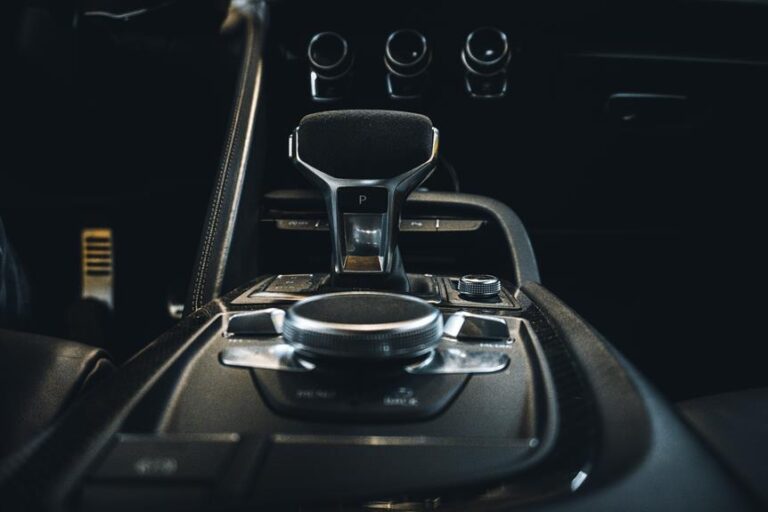Stay Balanced: Sway Bars and Suspension Tuning
Balancing the behavior of vehicles is vital, and sway bars significantly contribute to this stability. This comprehensive guide delves into the dynamics of sway bars, their role in suspension systems, and the importance of adjustability for optimal performance. It also provides troubleshooting strategies for common sway bar issues, along with expert advice on suspension tuning. This technical yet accessible guide is an essential resource for those seeking to understand and master the art of vehicle balance through sway bars and suspension tuning.
Key Takeaways
- Sway bars reduce body roll during turns and enhance handling and stability.
- Adjustable sway bars allow for customization of suspension tuning and provide adaptability in regulating vehicle balance and stability.
- Proper installation and adjustment of sway bars is essential for optimizing vehicle performance and unlocking their full potential.
- Regular maintenance and troubleshooting of sway bar problems are important for maintaining enhanced vehicle performance and tailoring settings to driving conditions.
Understanding the Basics of Sway Bars
Before one can truly master the art of suspension tuning, it is essential to grasp the fundamental concept of what a sway bar is and how it functions. A sway bar, also known as a stabilizer bar, is a fundamental component of a vehicle's suspension system. Its primary task is to reduce body roll during sharp turns or over uneven surface, thus enhancing the vehicle's handling and stability.
Adjustable sway bars, a more sophisticated variant, allow drivers to modify the stiffness of the bar, thereby adding a level of customization to suspension tuning. By altering the sway bar setting, one can essentially dictate the vehicle's understeer or oversteer response, a critical factor in tuned suspension geometry.
Understanding sway bars is paramount for anyone aspiring to optimize their vehicle's performance. The right tuning and adjustment of these components can significantly enhance the vehicle's cornering ability and overall stability. On roads less traveled or on the race tracks, this acquired knowledge can be the distinction between a thrilling ride and a mediocre one.
Now that we have established a comprehensive understanding of sway bars, we can delve deeper into the role of sway bars in vehicle suspension.
Role of Sway Bars in Vehicle Suspension
Sway bars, robust metal rods integral to a vehicle's suspension system, play a pivotal role in maintaining vehicle balance and preventing excessive body roll during turns. They are designed to resist torsional flexing, providing a more stable and controlled driving experience.
The effectiveness of sway bars is amplified when used in conjunction with racing brakes and suspension lowering kits. Racing brakes enhance the vehicle's stopping power, while suspension lowering kits reduce the center of gravity, further improving handling and stability.
Consider the following table that elucidates the advantages and drawbacks of sway bars:
| Advantages | Drawbacks |
|---|---|
| Improved handling and stability | Harsher ride due to stiffened suspension |
| Prevents excessive body roll | Potential understeer in over-tuned systems |
| Enhanced balance when used with racing brakes and suspension lowering kits | May not be suitable for all types of terrain |
The Significance of Adjustable Sway Bars
Adjustable sway bars present an essential aspect of suspension tuning, offering unparalleled adaptability in regulating a vehicle's balance and stability. Their significance is amplified by their benefits, including the capacity to fine-tune the suspension system to a driver's preference or the conditions of the road. We will now proceed to examine the advantages of adjustable sway bars, in addition to their installation and adjustment processes, to underscore their role in enhancing vehicle performance.
Adjustable Sway Bars Benefits
The utilization of adjustable sway bars in vehicle suspension systems offers several significant benefits that enhance the driving experience.
- Improved Handling: By allowing for stiffness adjustment, these sway bars provide the driver with the ability to fine-tune the vehicle's handling characteristics. This leads to a more responsive and stable ride, particularly during sharp turns or high-speed maneuvers.
- Versatility: With the adjustable feature, drivers can modify the vehicle's suspension settings to suit different driving conditions or styles, offering an unparalleled level of driving freedom.
- Reduced Body Roll: Adjustable sway bars significantly diminish body roll, facilitating a smoother driving experience and improved cornering performance.
- Ease of Installation: Despite their complex function, adjustable sway bars are relatively simple to install and adjust, making them an accessible upgrade for many vehicle owners.
Installation and Adjustment
Understanding a vehicle owner's role in the installation and adjustment of their sway bars, and the significant impact it can have on performance, is crucial to fully leveraging the benefits of this suspension tuning component. Adjustable sway bars give users the freedom to modify the vehicle's balance, allowing for more precise control over understeer and oversteer characteristics.
| Adjustable Sway Bars | Impact on Performance | Adjustment Process |
|---|---|---|
| Front Sway Bar | Reduces Understeer | Adjust Stiffness |
| Rear Sway Bar | Reduces Oversteer | Adjust Balance |
| Balanced Setup | Optimal Performance | Fine-tune Both |
This comprehensive understanding of the significance of adjustable sway bars can lead to a liberation of potential vehicle performance. In the following section, we will delve into the specific steps to adjust sway bars for optimal performance.
Steps to Adjust Sway Bars for Optimal Performance
Optimal vehicle performance is dependent on properly adjusted sway bars, a critical component of the suspension system. These bars, when finely tuned, can drastically improve your vehicle's handling and stability, granting you a level of control that liberates you from the constraints of an untamed ride.
Adjusting sway bars for optimal performance involves a precise, step-by-step process:
- Determine the Current State: Examine the vehicle's current handling characteristics. Note any excessive body roll, understeer, or oversteer.
- Adjust the Sway Bar Setting: Based on your observations, adjust the sway bar's stiffness. A stiffer bar can reduce body roll and oversteer, while a softer setting can mitigate understeer.
- Test Drive and Evaluate: Undertake a test drive to assess how the adjustment has impacted the vehicle's handling. Notice any changes in body roll, understeer, and oversteer.
- Fine-tune: Based on your evaluation, fine-tune the sway bars until you achieve the desired handling characteristics.
Troubleshooting Common Sway Bar Problems
Navigating the terrain of sway bar issues requires a keen understanding of the symptoms and solutions. On this journey, we will first elucidate the methodologies for accurate identification of common sway bar problems. Subsequently, we will focus on effective resolution strategies, fortified by expert advice and industry best practices.
Identifying Sway Bar Issues
In the realm of suspension tuning, diagnosing problems with your sway bar, or anti-roll bar, can often come down to discerning unusual noises or irregularities in your vehicle's handling.
- Listen for persistent rattling or clunking noises, especially during turns. This could indicate worn or broken sway bar links.
- Feel for excessive body roll or a feeling of instability during cornering. This might mean your sway bar bushings are deteriorating.
- Watch for uneven tire wear, a sign of misaligned suspension components, possibly due to a damaged sway bar.
- Notice if your vehicle leans to one side, indicative of a broken sway bar.
Understanding these symptoms is the first step to liberation from sway bar issues. Let's move on to resolving these problems.
Resolving Sway Bar Problems
Addressing common sway bar problems involves a blend of careful inspection, accurate diagnosis, and appropriate rectification methods. Start by conducting a visual examination for any visible signs of wear or damage, such as cracks, bends or broken links. Use a torque wrench and consult the sway bar's torque specifications to ensure all bolts are tightened correctly. A common problem is excessive noise, often solved by lubricating the sway bar bushings. If the issue persists, consider replacing the bushings or the entire sway bar if necessary. In cases of severe body roll, an upgrade to a stiffer sway bar could be beneficial. Remember, diagnosis and remedy should align to the specific symptoms and severity of the sway bar problem.
Expert Tips for Suspension Tuning With Sway Bars
Regularly adjusting your sway bars is crucial for optimal suspension tuning, and can significantly enhance your vehicle's performance. Properly tuned sway bars can lead to improved handling, better stability, and increased comfort during the ride.
Here are a few expert tips for suspension tuning with sway bars:
- Measure Your Sway Bars Properly: Use precise tools to measure the diameter of your sway bars. This can influence the stiffness of your suspension, and in turn, your vehicle's handling.
- Adjust According to Driving Conditions: Your sway bar settings should be tailored to specific driving conditions. For instance, a softer setting is preferable for rough terrains while a stiffer setting suits high-speed track driving.
- Balance is Key: Aim for a balanced setup between the front and rear sway bars. A disproportionate setup can cause oversteer or understeer, compromising the handling of your vehicle.
- Regular Maintenance: Keep your sway bars well-lubricated and free from rust or damage. This ensures their optimal functioning and longevity.
Frequently Asked Questions
What Are the Cost Considerations When Upgrading to Adjustable Sway Bars?
When considering the upgrade to adjustable sway bars, costs can vary widely. Factors include the product's brand, quality, installation charges, and potential need for supplementary suspension components. Research and comparison shopping are crucial for cost-effective choices.
How Does Weather and Road Conditions Affect the Performance of Sway Bars?
Weather and road conditions significantly impact sway bar performance. Wet or icy surfaces can reduce friction, affecting stability, while uneven terrain can strain the suspension system, compromising the sway bar's effectiveness in maintaining balance.
Can Sway Bars Improve a Vehicle's Fuel Efficiency?
Yes, sway bars can indirectly improve a vehicle's fuel efficiency. By enhancing stability and reducing body roll during turns, they promote more uniform tire wear, which can lead to better gas mileage over time.
How Often Should Sway Bars Be Replaced or Serviced?
Sway bars should be inspected during routine vehicle maintenance. Replacement or servicing is typically needed when signs of wear or damage are evident, which can vary greatly, depending on driving conditions and vehicle usage.
Are There Any Specific Brands or Manufacturers of Sway Bars That Are Recommended by Experts?
Experts often recommend sway bars from brands such as Eibach, H&R, and Whiteline, due to their superior performance and durability. These manufacturers provide high-quality products that consistently meet or exceed industry standards.
Conclusion
In conclusion, sway bars play a pivotal role in maintaining vehicle balance, enhancing suspension performance, and ensuring optimal driving safety. Proper adjustment and regular troubleshooting of these components are crucial to prevent potential vehicle instability. Leveraging the flexibility of adjustable sway bars allows for precision tuning, enabling drivers to 'have the best of both worlds' with regards to performance and comfort. As such, understanding and utilizing sway bars effectively is a cornerstone of comprehensive suspension tuning.






